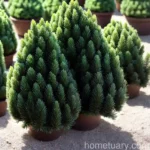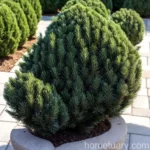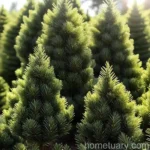Colorado Spruce (Picea pungens ‘Thume’)
Plants play a pivotal role in the ecological balance of our environment. They not only provide oxygen, but also serve as a source of food, raw materials, and contribute to the aesthetics of our surroundings. In this article, we will delve into the intricacies of the Colorado Spruce, scientifically known as Picea pungens ‘Thume’, a delightful and popular evergreen tree that brings beauty and functionality to landscapes, gardens, and natural habitats alike.
What is a Plant: Colorado Spruce (Picea pungens ‘Thume’)?
Colorado spruce, also known as blue spruce, is a species of spruce tree native to the Rocky Mountains of the United States. The ‘Thume’ variety is a particular cultivar of the Colorado spruce that is highly regarded for its unique characteristics and striking appearance. In this section, we will explore the various aspects of this remarkable plant, including its cultural significance, uses, growth requirements, care tips, and potential challenges in cultivation.
Key Takeaways – Colorado Spruce (Picea pungens ‘Thume’)
The Colorado spruce (Picea pungens ‘Thume’) is a visually stunning evergreen tree that offers a range of benefits in landscaping and horticulture. Its distinct blue foliage and hardy nature make it a sought-after choice for gardens, parks, and natural settings. Let’s delve into the key takeaways of this captivating plant to gain a comprehensive understanding of its characteristics, care needs, and potential applications.
Culture
- Scientific Name: Picea pungens ‘Thume’
- Common Names: Colorado spruce Thume, Thume blue spruce, Colorado blue spruce Thume, Thume Colorado spruce variety
- Growth Habit: Conical when young, becoming irregularly cylindrical with age
- Foliage Color: Intense silver-blue needles, persisting year-round
- Native Habitat: Rocky Mountains of the United States
The ‘Thume’ cultivar of the Colorado spruce exhibits remarkable visual appeal with its distinctive blue foliage, making it a favored choice for landscaping and ornamental use.
Uses
The Colorado spruce (Picea pungens ‘Thume’) serves a multitude of practical and aesthetic purposes, making it a versatile addition to diverse environments. Its uses include:
- Ornamental Tree: The striking blue coloration of the needles and the graceful form make it an attractive specimen tree in landscapes and gardens.
- Privacy Screen: Due to its dense growth habit and year-round foliage, it is commonly utilized as a natural screen for privacy and windbreaks.
- Wildlife Habitat: The tree provides shelter and protection for various wildlife, contributing to biodiversity in natural habitats.
- Erosion Control: Its extensive root system and adaptability make it effective in stabilizing soil and controlling erosion in landscapes.
These diverse applications highlight the value of the Colorado spruce ‘Thume’ in horticulture, conservation, and landscape design.
Water
Proper water management is critical for the health and vigor of Colorado spruce trees. While they are drought-tolerant once established, adequate moisture is essential during the establishment period and in times of prolonged dryness. Here are some key points for watering the Picea pungens ‘Thume’:
- Establishment: Newly planted trees require consistent watering to ensure the development of a healthy root system. Water deeply and regularly, especially during hot and dry periods.
- Mature Trees: Once established, Colorado spruce ‘Thume’ generally withstands dry spells, but supplemental watering during extended droughts can help maintain their vitality and appearance.
- Frequency: Water deeply and infrequently rather than shallow, frequent watering. This encourages the development of a deep, robust root system that enhances the tree’s resilience to drought stress.
- Soil Moisture: Regularly monitor soil moisture levels, especially during dry seasons. When the top few inches of soil feel dry, it’s time to water.
By adhering to proper watering practices, you can promote the overall health and well-being of your Colorado spruce ‘Thume’ trees while ensuring their longevity and beauty.
Sunlight
Colorado spruce ‘Thume’ thrives in full sun to partial shade conditions. Adequate sunlight is essential for the plant’s growth, development, and the expression of its striking blue foliage color. Here are some key considerations for sunlight requirements:
- Full Sun: Ideally, provide the tree with at least 6 to 8 hours of direct sunlight daily for optimal growth and foliage coloration.
- Partial Shade: While the tree prefers full sun, it can tolerate partial shade, especially in hot climates, provided it still receives a few hours of direct sunlight.
- Site Selection: When planting a Colorado spruce ‘Thume’, choose a location that offers ample sunlight while providing some protection from harsh afternoon sun in hot regions.
Balancing the sunlight exposure is crucial to harness the full potential of the tree’s visual appeal and ensure its robust growth over time.
Fertilizer
Fertilization plays a significant role in sustaining the health and vitality of Colorado spruce ‘Thume’ trees. While these trees are generally low-maintenance, providing essential nutrients can enhance their vigor and appearance. Consider the following aspects of fertilizing Picea pungens ‘Thume’:
- Timing: Fertilize in early spring before new growth emerges to support the tree’s seasonal development.
- Type: Utilize a balanced, slow-release fertilizer specifically formulated for evergreen trees to provide a steady supply of nutrients over an extended period.
- Application: Apply the fertilizer evenly around the tree’s drip line, avoiding direct contact with the trunk, and irrigate thoroughly to facilitate nutrient uptake.
- Frequency: A single annual application of fertilizer in spring is typically adequate for Colorado spruce ‘Thume’, as excessive fertilization can lead to nutrient imbalances and adverse effects on the tree.
By implementing a well-targeted fertilization regimen, you can fortify the health and resilience of your Colorado spruce ‘Thume’ trees while fostering their ornamental allure.
Soil
The soil composition and quality play a pivotal role in the growth and performance of Colorado spruce ‘Thume’. Understanding the soil preferences of this tree is essential for successful cultivation. Here are key considerations related to soil for Picea pungens ‘Thume’:
- Well-Drained Soil: Colorado spruce ‘Thume’ thrives in well-drained, loamy soils with good aeration and moisture retention properties.
- Soil pH: The tree prefers slightly acidic to neutral soil pH, typically in the range of 5.5 to 7.0. Conduct a soil test to evaluate the pH and address any necessary adjustments.
- Site Conditions: Avoid poorly drained or compacted soils, as they can hinder root development and lead to moisture-related issues.
By selecting an appropriate planting site and ensuring favorable soil conditions, you can lay the groundwork for the healthy establishment and sustained growth of your Colorado spruce ‘Thume’ trees.
Pruning
Pruning is an integral component of tree care and maintenance, contributing to the overall health, aesthetics, and structural integrity of Colorado spruce ‘Thume’ trees. Understanding the principles and best practices of pruning is essential for achieving desirable outcomes. Consider the following aspects of pruning for Picea pungens ‘Thume’:
- Timing: Prune the tree during its dormant season, preferably in late winter to early spring, to minimize stress and promote efficient wound healing.
- Pruning Objectives: Focus on eliminating dead, damaged, or diseased branches, shaping the tree, and managing its size to maintain a balanced and attractive form.
- Techniques: Utilize clean, sharp pruning tools and make precise, angled cuts to facilitate proper healing and minimize the risk of bark damage or disease entry.
By adhering to sound pruning techniques and guidelines, you can enhance the visual appeal, structural integrity, and longevity of your Colorado spruce ‘Thume’ trees while promoting their overall health.
Propagation
Colorado spruce ‘Thume’ can be propagated through several methods, including seeds, cuttings, and grafting. Each approach has its advantages and considerations, enabling the proliferation of this exceptional cultivar for various horticultural and landscaping applications. Let’s explore the propagation techniques for Picea pungens ‘Thume’:
- Seed Propagation: Collect mature cones from the tree and extract the seeds for sowing. Stratify the seeds in a cold, moist environment for a few months before planting to stimulate germination.
- Cutting Propagation: Root softwood cuttings taken in early summer or semi-hardwood cuttings obtained in late summer using a rooting hormone and well-draining medium.
- Grafting: Utilize grafting techniques to unite a ‘Thume’ scion with a compatible rootstock, ensuring the retention of the desired traits and characteristics.
By employing suitable propagation methods, you can expand the presence and availability of Colorado spruce ‘Thume’, contributing to its sustained cultivation and utilization in diverse settings.
Container Popularity
The container cultivation of Colorado spruce ‘Thume’ is gaining popularity among gardening enthusiasts, owing to its potential for versatile use, space-saving benefits, and ease of maintenance. This section will explore the factors contributing to the appeal and practicality of growing Picea pungens ‘Thume’ in containers:
- Aesthetic Appeal: The compact size and striking blue foliage of ‘Thume’ make it an ideal candidate for container growing, adding a captivating visual element to patios, decks, and entryways.
- Space Utilization: Containers enable the cultivation of Colorado spruce ‘Thume’ in urban and confined spaces, expanding the opportunities for incorporating this charming evergreen into diverse environments.
- Portability: Container-grown ‘Thume’ trees offer the flexibility to relocate them based on seasonal considerations, design preferences, or space constraints, enhancing their functional adaptability.
- Cultural Control: Container cultivation allows for precise management of soil, moisture, and environmental conditions, enabling tailored care and optimization of the tree’s growth.
By embracing container cultivation, you can harness the ornamental and practical advantages of Colorado spruce ‘Thume’, enriching your outdoor spaces with its captivating presence and natural charm.
Container Common Diseases
While growing Colorado spruce ‘Thume’ in containers offers numerous benefits, it also necessitates attentiveness to potential disease risks that can impact the tree’s health and vitality. Understanding the common diseases associated with container-grown Picea pungens ‘Thume’ is crucial for implementing preventive measures and proactive management. Consider the following potential diseases and their management strategies:
- Needlecast: Watch for signs of needle discoloration, premature needle drop, and fungal fruiting bodies on needles. Provide proper air circulation, maintain soil drainage, and consider fungicidal treatments if necessary.
- Root Rot: Monitor soil moisture levels and avoid overwatering, which can lead to root rot. Utilize well-draining potting mix, and consider the use of fungicidal drenches if symptoms of root rot manifest.
- Cytospora Canker: Look out for sunken cankers, resinous bleeding, and dieback of branches. Prune and remove affected branches, maintain tree vigor through proper care, and consider fungicidal control if the disease persists.
Proactive monitoring, cultural practices, and timely intervention can help safeguard container-grown Colorado spruce ‘Thume’ from common diseases, promoting their sustained health and ornamental value.
Disease Diagnosis
Effective disease diagnosis is instrumental in identifying and addressing potential health issues affecting Colorado spruce ‘Thume’ trees. By recognizing the symptoms, causes, and management strategies for prevalent diseases, enthusiasts and horticultural practitioners can actively protect the health and vitality of these remarkable trees. Here’s a succinct overview of the disease diagnosis process for Picea pungens ‘Thume’:
- Symptom Identification: Observe the tree for visible signs of disease, such as foliage discoloration, wilting, dieback, cankers, or abnormal growth patterns.
- Causal Analysis: Investigate the potential causes of the observed symptoms, which may include fungal pathogens, environmental stress, or cultural factors.
- Diagnostic Tools: Utilize diagnostic resources, such as local extension services, plant clinics, and professional arborists, for accurate disease identification and tailored management recommendations.
By employing a systematic and thorough approach to disease diagnosis, you can effectively address potential health challenges and preserve the well-being of your Colorado spruce ‘Thume’ trees.
Common Pests
Colorado spruce ‘Thume’ trees are susceptible to certain pest infestations that can compromise their health and aesthetic appeal. Familiarizing oneself with the common pests and their management strategies is essential for preemptive measures and targeted interventions to mitigate pest-related risks. Here are some prevalent pests that may affect Picea pungens ‘Thume’:
- Spruce Spider Mites: Monitor for stippled foliage, fine webbing, and mite activity. Consider horticultural oil applications to suppress mite populations and maintain tree vigor.
- Spruce Gall Adelgid: Watch for abnormal swellings or galls on shoots and branches. Implement targeted insecticide treatments during the crawler stage to manage adelgid infestations.
- Spruce Needleminer: Look out for distorted, discolored needles and the presence of larvae in mined needles. Employ cultural practices and insecticidal control measures to reduce needleminer damage.
By remaining vigilant and proactive in pest monitoring and management, you can safeguard the health and visual appeal of your Colorado spruce ‘Thume’ trees, ensuring their sustained vitality in diverse settings.
Botanist’s Tips
Drawing upon botanical insights and practical wisdom is integral to successfully cultivating and appreciating Colorado spruce ‘Thume’ trees. The following tips from plant science and horticultural experts can guide enthusiasts, gardeners, and professionals in optimizing the care, growth, and utilization of Picea pungens ‘Thume’:
- Site Selection: Choose a well-drained planting site with ample sunlight and adequate space for the tree to thrive and express its natural beauty.
- Soil Preparation: Prior to planting, amend the soil with organic matter to enhance fertility, structure, and moisture retention, ensuring favorable conditions for root establishment.
- Mulching: Apply a layer of organic mulch around the base of the tree to conserve soil moisture, suppress weed growth, and moderate soil temperature.
- Seasonal Care: Tailor your care practices based on seasonal nuances, adapting watering, fertilization, and pruning routines to accommodate the tree’s changing requirements.
- Integrated Pest Management: Embrace holistic pest management strategies that prioritize cultural practices, beneficial organisms, and targeted control measures to sustain a healthy tree ecosystem.
By integrating these botanist-approved tips into your Colorado spruce ‘Thume’ care regimen, you can nurture robust, visually stunning trees and maximize their potential in diverse environments.
Fun Facts
Discovering intriguing and captivating details about Colorado spruce ‘Thume’ adds depth to the appreciation and admiration of this remarkable tree. Here are some fun facts and notable attributes that illuminate the unique charm and significance of Picea pungens ‘Thume’:
- State Tree of Colorado: The Colorado blue spruce, including the ‘Thume’ variety, serves as the state tree of Colorado, symbolizing its natural heritage and enduring beauty.
- Historical Significance: Indigenous peoples and early settlers utilized the tough, flexible wood of the blue spruce for crafting tools, utensils, and shelter, highlighting its historical utility and cultural relevance.
These captivating details enrich our understanding and admiration of Colorado spruce ‘Thume’, elevating its significance in horticulture, conservation, and cultural heritage.
Links to External Resources
To further expand your knowledge and exploration of Colorado spruce ‘Thume’ and related topics, consider accessing the following external resources:
-
American Conifer Society: Visit the society’s website to access comprehensive information on various conifer species, including the Colorado spruce ‘Thume’, and connect with fellow conifer enthusiasts.
-
University Extension Services: Explore the extension resources offered by leading universities for insightful articles, fact sheets, and guides related to tree cultivation, care, and pest management.
-
Arboricultural Organizations: Access the resources provided by arboricultural organizations to delve into tree care, maintenance guidelines, and professional insights from certified arborists.
Conclusion
Colorado spruce (Picea pungens ‘Thume’) stands as a testament to nature’s artistry, resilience, and practical value, enriching landscapes, gardens, and natural habitats with its captivating presence. By delving into the plant’s cultural heritage, growth requirements, care practices, and intrinsic allure, we gain a profound appreciation for the art and science of tree cultivation. Whether adorning a suburban garden or gracing a sprawling estate, the ‘Thume’ variety of the Colorado spruce embodies the timeless allure of nature’s wonders, inviting us to cherish and sustain its botanical legacy for generations to come.















